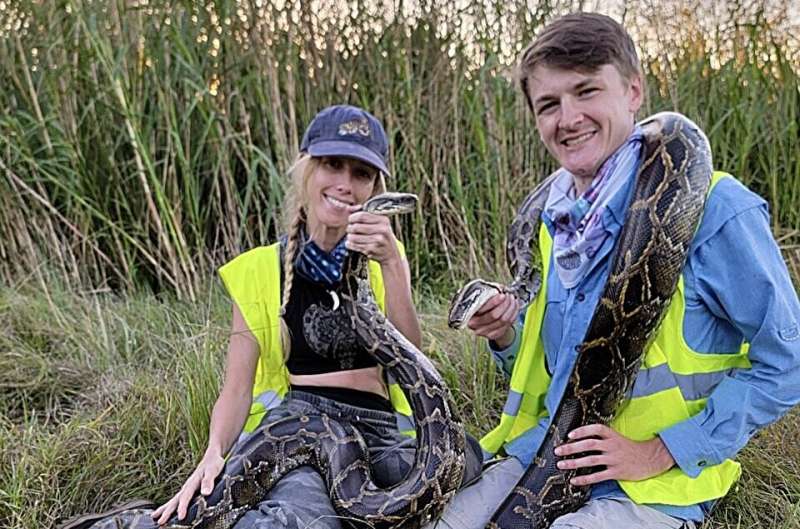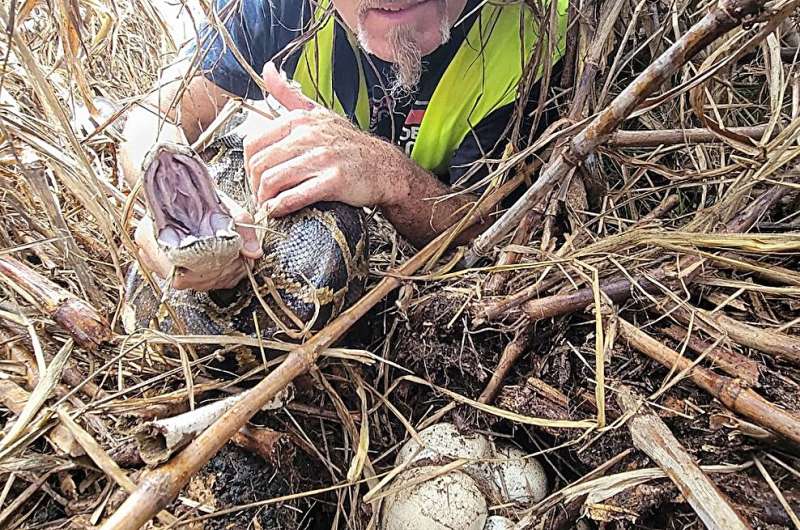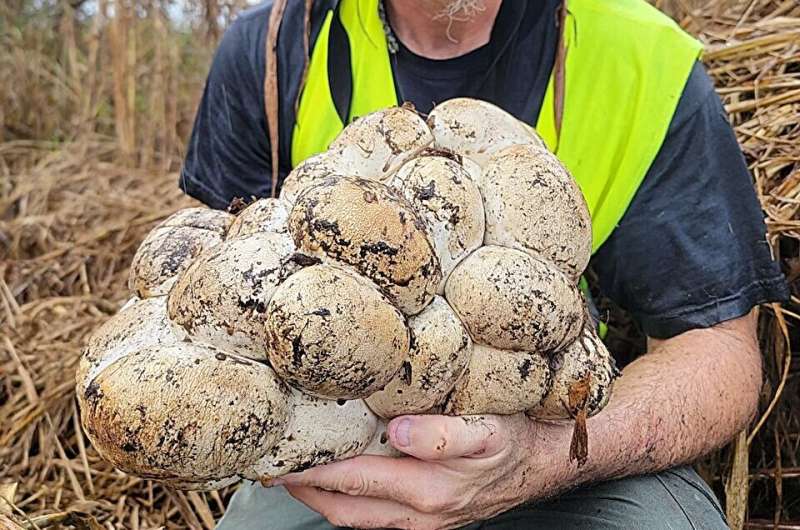This article has been reviewed according to Science X's editorial process and policies. Editors have highlighted the following attributes while ensuring the content's credibility:
fact-checked
peer-reviewed publication
trusted source
proofread
Cracking the Burmese python code: Data analysis reveals optimal strategies for removing them from Florida

University of Florida scientists have statistically analyzed large amounts of data collected by Burmese python contractors, revealing critical insights about how to most efficiently remove the reptiles.
Researchers correlated survey outcomes, including python removals, with survey conditions, using statistical modeling. For example, the researchers examined if factors like time or temperature impacted the chance of removing a python. They also analyzed whether the most surveyed areas aligned with the highest python removals. This allowed the researchers to identify regions where few contractors are catching a lot of pythons, indicating more contractors working in these locations could result in more pythons removed.
"This collaboration among the UF Institute of Food and Agricultural Sciences (IFAS), South Florida Water Management District (SFWMD), and the contractors increases our ability to detect and remove pythons by providing guidelines for when and where to survey to optimize your chances of finding a python," said Melissa Miller, an invasion ecologist at UF/IFAS Fort Lauderdale Research and Education Center.
"Targeted surveys, guided by these data, can allow us to be more efficient and successful in our efforts to control Burmese pythons." These data were collected as part of the SFWMD Python Elimination Program between May 2020 and April 2022. The researchers from UF/IFAS analyzed 4,092 surveys from python contractors totaling over 16,000 hours of effort. The research is published in the journal Scientific Reports.

Researchers identified two regions where python removals could likely be increased with more surveys. These regions occurred toward the western edge of Big Cypress National Preserve along the Tamiami Trail and a stormwater treatment area in Palm Beach County. Additionally, researchers identified optimal conditions that improve survey outcomes, providing specific guidelines for contractors.
Based on their findings, researchers developed key recommendations to enhance python removal efforts:
- Surveys are most successful and efficient during the wet season from May to October.
- A drop in barometric pressure from the previous day, increases the likelihood of successful surveys.
- The most efficient survey period is between 8 pm to 2 am.
- Aquatic vehicles, including motorboats, canoes, kayaks, and airboats, enhance survey effectiveness.
- Nighttime surveys generally yield better results than daytime surveys, except during extreme cold events, such as mean daily air temperatures of 50 degrees Fahrenheit or lower.
Scientists see this as a pivotal point in research that now provides guidelines supported by data for successful detection and removal efforts from this point forward and all thanks to citizen science, researchers said.

"Pythons disrupt food webs, altering predator-prey dynamics and reducing populations of key native species. By refining removal strategies, we're working to give native wildlife a chance to adapt and persist," said Alex Romer, a quantitative ecologist at UF/IFAS Fort Lauderdale Research and Education Center and corresponding author on the paper.
The study highlights effective python management strategies and demonstrates how researchers, natural resource managers and residents can collaborate to improve wildlife conservation.
"Managing pythons is an enormous effort, undertaken by Floridians deeply invested in restoring the intricate ecological processes that define the Everglades," said Romer. "This work is about safeguarding one of the world's most unique ecosystems—not just for today, but for generations to come."
More information: Kelly R. McCaffrey et al, Optimizing survey conditions for Burmese python detection and removal using community science data, Scientific Reports (2025). DOI: 10.1038/s41598-024-84641-4
Journal information: Scientific Reports
Provided by University of Florida


















